Toyota Motor Corporation (Toyota) unveiled the interior of Japan's manned lunar rover, "Lunar Cruiser." The rover is currently under research and development. It is expected to play an active role in the international lunar exploration by the United States, Europe and Japan. A prototype of the vehicle for technological verification was displayed at an exhibition of advanced technologies, including automobiles. Visitors were provided an early glimpse of the near-future "Japanese lunar surface rover" through a simulated driving experience. When realized, the rover will play a leading role in next-generation manned lunar exploration. Visitors lined up for a glimpse of the exhibited lunar surface rover.
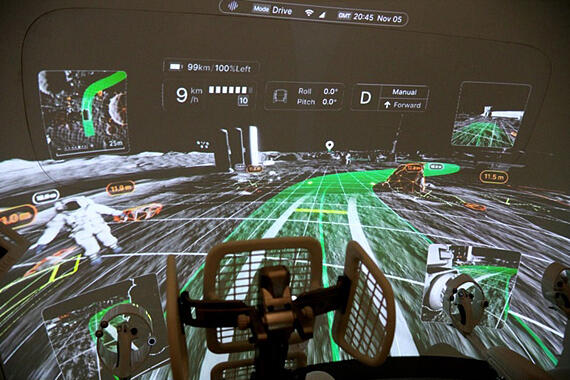
(At Tokyo Big Sight, Kōtō City, Tokyo)
Demonstrating true capabilities in the fusion of automobile technology and manned space technology
The Lunar Cruiser is intended for use in the U.S.-led international lunar exploration program "Artemis." The exploration vehicle used in the U.S. Apollo 15—17 missions (1971—72) was an unpressurized variant with the driver's seat exposed. Meanwhile, this rover is a pressurized type that enables astronauts to safely remove their spacesuits for extravehicular mobility and to be able to pass time in casual clothes inside the vehicle. After joint research with the Japan Aerospace Exploration Agency (JAXA), Toyota will begin full-scale development next year, aiming for launch in 2029. Mitsubishi Heavy Industries Ltd., with its expertise in developing the Japanese Experiment Module "Kibo" on the International Space Station (ISS), will also collaborate in the development.
The National Aeronautics and Space Administration (NASA) has expectations for Japan to provide a manned pressurized rover. Japan has a strong automobile industry and has cultivated manned space technology through the "Kibo" experimental module and other projects. It should be capable of demonstrating its strengths in the development of manned pressurized rover. It will be noteworthy when a Japanese rover travels across the surface of the Moon in the short-to-medium term.
Toyota exhibited a full-scale prototype of the rover interior used for technology verification at the Japan Mobility Show (formerly Tokyo Motor Show), held in Tokyo from October 26 to November 5 in 2023. This enabled visitors to step inside and simulate the experience of driving.
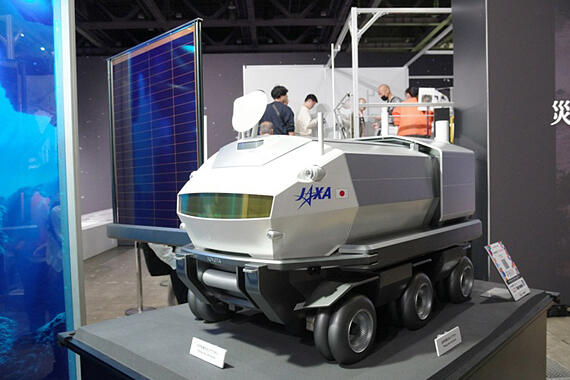
(Kōtō City, Tokyo)
Astronauts enter and exit through the rear door of the rover. The interior walls are predominantly white. After traversing the chamber for adjusting air pressure and wearing/removing spacesuits, one reaches a living space with a size of approximately four-and-a-half tatami mats. The driver's seat is located at the back of the rover. The author made a reservation, informed them of the purpose of visiting (for an interview) in advance and had a 15-min driving experience.
Using the large VR screen as a guide, let's start!
The front of the rover has a large screen that utilizes virtual reality (VR) to project the direction of travel on the lunar surface. The recommended safe route is shown in green, similar to a road. Two thick gray lines indicate the direction in which the rover is being steered. A camera on the rover captures images of its surroundings while traveling. The computer processes this information moment by moment and displays the distance to hazardous obstacles such as rocks and craters, on the screen in real time. The speed and posture of the rover are also displayed.

It was unexpected that the rover would rely on video images as a navigational aid, despite the presence of a structure resembling a windshield in the conceptual drawings of the rover and the model displayed at the exhibition site. The person in charge provided the following reason, "The windows are installed for the mental health of the astronauts rather than driving. These do not permit the astronauts to observe the lower part of the vehicle. Moreover, near the south pole of the Moon, where exploration is likely to be conducted, sunlight shines almost horizontally. If the shadow of the rover falls toward the direction of its travel, the path immediately in front becomes completely dark. It is most effective and safest to capture images with a camera and project these on a screen."
After the participant sits in the driver's seat and receives a signal from the ground controller, the rover is ready to take off. It has control sticks on the left and right. I mainly used the right control stick. Adjacent to the hand holding the control stick is the accelerator button. It is pressed to accelerate and released to brake. Left and right steering are performed by operating a lever with the thumb. It also has an "R" button, which is to be pressed to drive in reverse. It appears that the left control stick is to be used while driving in reverse, e.g., to switch the screen perspective.
The rover started off fairly well. Essentially, it appears to be maneuverable as long as the gray lines on the steering wheel are maintained within the recommended green route. When the route is flat, the rover travels at a speed of approximately 10 km/h. Cornering was also completed. Soon, however, the rover came to a spot where rocks on the left side of the road protruded marginally into the green area. The rover got caught in the rocky area and was stuck (unable to move). With the help of the person in charge, I reversed the rover and attempted again. However, this time I steered excessively far to the right. This caused the rover to go off the green route. During these trials, the rover apparently overturned. "Well, let's go back to the beginning. It looks like the rover cannot get out." The person in charge's voice sounded tense.
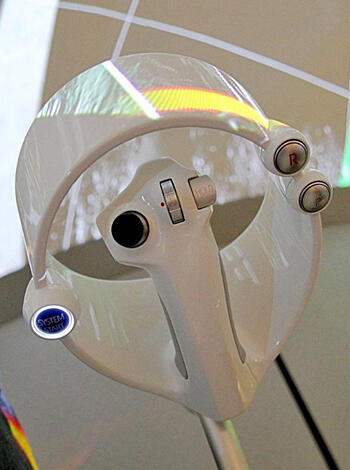
(Kōtō City, Tokyo)
Unable to move the rover as desired, I ended up in a state of mind where I was stuck between a rock and a hard place. The astronauts are required to address such situations calmly. I thought to myself, "No, a real astronaut would never be in such a situation in the first place." As I was considering this, the allotted time ran out. As someone who has been a paper driver for 23 years, driving a lunar rover was moderately difficult. Next time, I wish to attempt driving it on public roads. Of course, this experience was a consequence of the rover being in the stage of research and development and has the potential to improve with future development.
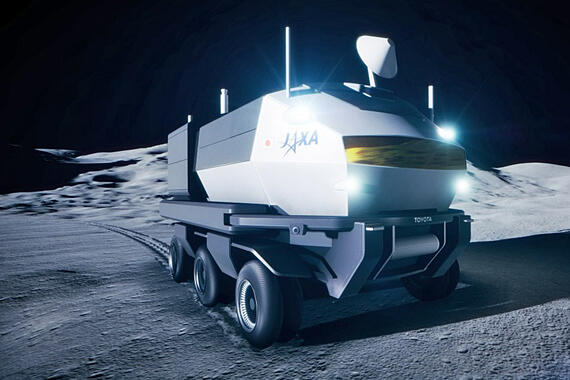
Provided by Toyota
A technology which serves to give back to society
The Artemis program, spearheaded by the U.S., is a large-scale international space exploration project that will succeed the International Space Station (ISS) program. The mission is to realize the first manned lunar landing since the Apollo 17 mission in 1972. The construction of Gateway, a space station in orbit around the Moon, will be advanced. Moreover, experiments and observations would be conducted to demonstrate the technologies from the perspective of future exploration of Mars. Japan decided to participate in the Artemis program in 2019. Following a joint declaration by the Ministry of Education, Culture, Sports, Science and Technology (MEXT) and NASA in 2020 and a Japan-U.S. summit in May 2022, the impetus for a Japanese landing on the Moon is growing.
The main body of the Lunar Cruiser has a length, width and height of 6 m, 5.2 m and 3.8 m, respectively. This is equivalent in size to two microbuses. Given the harsh environment of the Moon, which has a gravity one-sixth that of the Earth, temperatures ranging from 120 ℃ to -170 ℃ and strong radiation, the rover needs to be capable of protecting astronauts. It will be equipped with self-driving functions and be capable of unmanned operation.
Because GPS (satellite-based positioning system) cannot be used on the lunar surface, the rover needs technology to autonomously estimate its position and navigate while monitoring obstacles, gradients, and other data in real time. Verification tests are underway using a test vehicle to enable off-road driving for eight hours a day, six days in a row.
At the press conference in July 2023, Ken Yamashita, head of Toyota's Lunar Exploration Mobility Works Project, emphasized the aims of the development as follows: "We are aiming for technological improvement and human growth. We would not wait until 2029 to transfer the technologies developed by the project to society on the ground." Specifically, the four main technologies of the Lunar Cruiser are as follows: 1) regenerative fuel cells that are effective on remote islands and in disaster-stricken areas; 2) off-road capability, which enables the vehicle to travel over rocky terrain; 3) autonomous driving; and 4) "user experience (UX)," including comfort and convenience of operation.
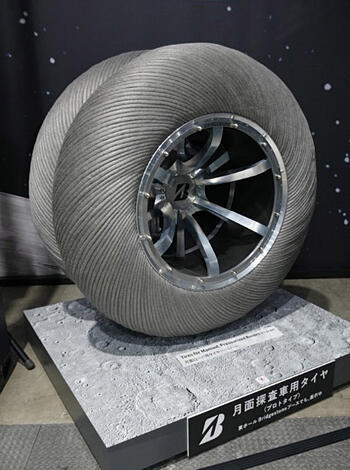
(Kōtō City, Tokyo)
Two individuals in a small four-and-a-half-tatami space...how to relieve stress?
I look forward to the day when astronauts, including Japanese, will ride the Lunar Cruiser on the Moon. However, when I actually entered the cabin of the Cruiser, I considered mental health care (such as stress management for astronauts) to be a key issue. It is challenging for two individuals to live in a four-and-a-half-mat room for a month, even on the Earth. After the astronauts step outside, a desolate monochrome world will spread out before them. There would be no convenience stores or Izakaya (a Japanese-style dining bar). On the ISS, flying 400 km above the Earth, astronauts continue to stay on a six-month rotation basis. Its size is approximately equal to that of a soccer court, and it has private rooms, albeit small.
For the Lunar Cruiser, the following concepts are being considered to alleviate stress for astronauts: 1) a counseling system by enabling communication with the ground, 2) projection of images depicting the Earth's natural beauty on the screen, 3) a device that emits fragrance toward the driver's seat, and 4) a lighting system that considers the body's biological clock. At the end of the driving experience, the person in charge stated, "The key challenge is that several individuals live in one place. We need to address these issues based on social psychology and other factors."
The issue of stress for astronauts will be the subject of UX technology. Yamashita has stated, "We wish to provide individuals placed in extreme conditions in a limited and confined space far from the Earth with safe and comfortable transportation and a healthy lifestyle that balances public and private life." How would this issue be solved in the limited space inside the rover? The issue is attracting attention because it is also linked to the feasibility of manned Mars exploration, which the U.S. aims to realize in the 2030s through international cooperation.
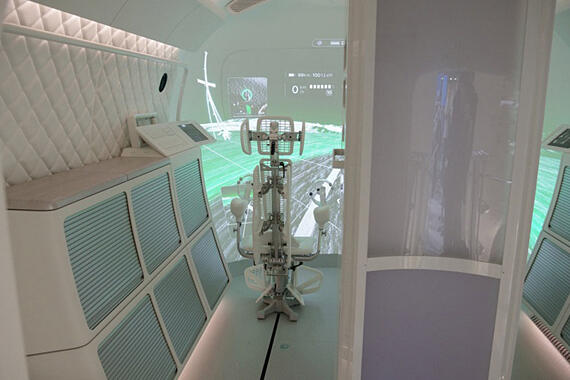
(Kōtō City, Tokyo)
The Japan Mobility Show (renamed after the Tokyo Motor Show) was held for the first time in four years since 2019. The venue was Tokyo Big Sight (Kōtō City, Tokyo). It attracted approximately 1.11 million visitors over 11 days, with 475 enterprises and organizations participating, including exhibitors from vehicle-related industries other than automobiles. Exhibitors promoted vehicles of the future that will transform society and our lives. These included highly advanced electric vehicles, fuel cell vehicles, self-driving cars, flying cars and mobile robots that carry humans.
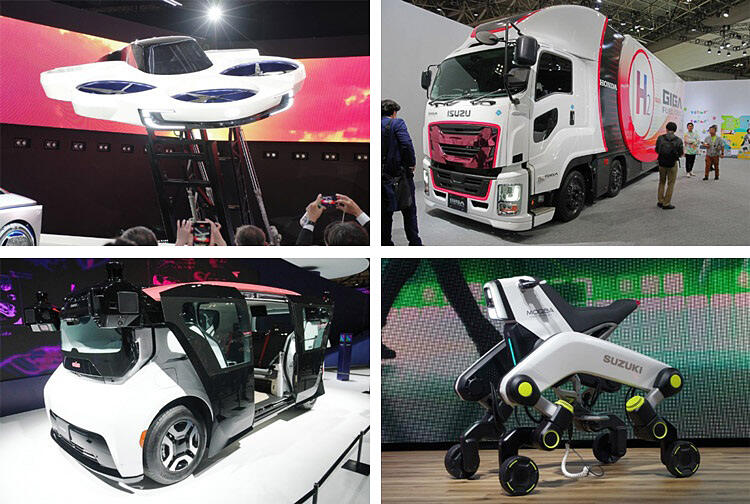
(KUSAKA Takeo / Science Portal Editorial Office)
Original article was provided by the Science Portal and has been translated by Science Japan.




